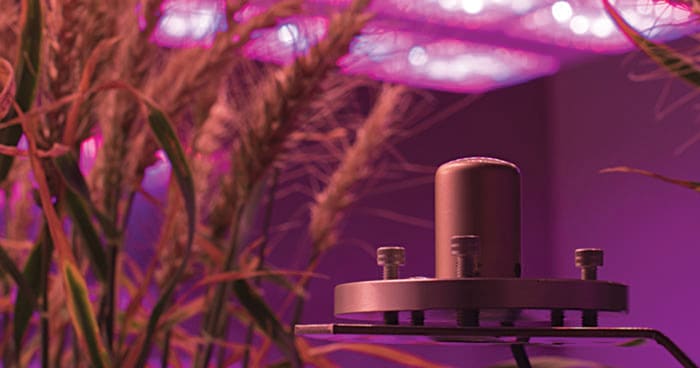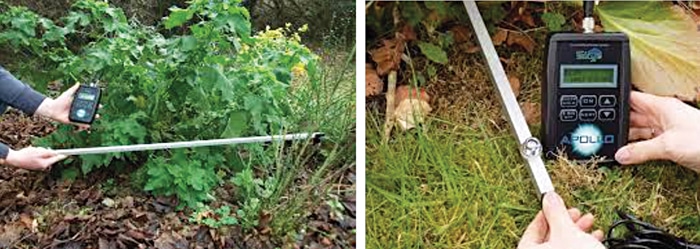PAR quantum sensors are revolutionising agriculture, shedding light on optimal growth and resource-efficient crop production—illuminating the path to healthier crops and greener thumbs
Photosynthetically active radiation (PAR) is a crucial parameter in understanding and monitoring the energy available for photosynthesis in plants and algae. PAR sensors play a pivotal role in quantifying this radiation and are widely used in agriculture, ecological studies, and indoor plant cultivation. These sensors provide valuable insights into light availability, allowing for optimal plant growth, yield prediction, and environmental monitoring.

PAR sensors are designed to measure the spectral range of light (usually between 400 and 700 nanometres) that drives photosynthesis. They capture the photons responsible for the energy transfer process in plants, influencing various physiological and biochemical processes. With the advancements in technology, PAR sensors have become more accurate, compact, and affordable, enabling their widespread adoption in both research and practical applications.
This article aims to explore the fundamental principles and applications of PAR sensors. We will delve into the working mechanisms of these sensors, including the use of photodiodes, filters, and calibration techniques. Additionally, we will discuss their applications in agriculture, horticulture, ecosystem monitoring, and indoor gardening. By understanding the capabilities and benefits of PAR sensors, researchers, farmers, and plant enthusiasts can make informed decisions and optimise the growth and productivity of photosynthetic organisms.
Working of PAR sensor
The working principle of a PAR quantum sensor involves the measurement of photons within a specific spectral range crucial for photosynthesis. PAR sensors typically utilise a photodiode, filters, and calibration techniques to accurately quantify the light energy available for photosynthetic processes in plants and algae.
At the core of a PAR quantum sensor is a photodiode, a semiconductor device that generates an electrical current when exposed to light. The photodiode used in a PAR sensor is typically designed to be sensitive to photons within the range of 400 to 700 nanometres, corresponding to the visible light spectrum absorbed by chlorophyll and driving photosynthesis.
To ensure accurate measurement of PAR, quantum sensors incorporate filters that selectively transmit light within the desired spectral range while blocking unwanted wavelengths. These filters help eliminate interference from other light sources and ensure that only photons within the photosynthetically active range are detected by the sensor.
Calibration is a critical step in the working of a PAR quantum sensor. It involves establishing a correlation between the electrical output of the photodiode and the actual PAR values. Calibration is typically performed using standardised light sources with known PAR values.
By exposing the sensor to these calibrated light sources, the response of the photodiode can be correlated with the incident PAR, allowing accurate measurements in real-world applications. When a PAR quantum sensor is placed in a light environment, the photodiode within the sensor detects the photons within the photosynthetically active range.
The photons strike the surface of the photodiode, causing the generation of electron-hole pairs. This leads to a flow of current, which is directly proportional to the intensity of the incident photons. The electrical output from the photodiode is then processed and converted into meaningful PAR values using calibration factors specific to the sensor.
The PAR readings obtained from the quantum sensor provide valuable information about the available light energy for photosynthesis, allowing researchers, farmers, and plant enthusiasts to optimise growing conditions, assess plant health, and make informed decisions for maximising crop yield or plant growth.
Application of PAR sensor in agriculture
PAR quantum sensors are widely used in agriculture for measuring and monitoring the light levels crucial for plant growth and development. These sensors detect the quantity and quality of light within the PAR range (400-700 nanometres) and provide valuable information for optimising crop production. Here are some of the key applications of PAR quantum sensors in agriculture:

Crop management
PAR quantum sensors help farmers and growers assess the light intensity and distribution in their fields or greenhouses. This information enables them to make informed decisions about crop placement, shade management, and supplemental lighting. By ensuring that plants receive an optimal amount of light, farmers can enhance photosynthesis, increase yields, and improve overall crop quality.
Light mapping
These quantum sensors can be used to create light maps of growing areas, enabling growers to identify areas with inadequate or excessive light. This information allows for the adjustment of lighting setups or the implementation of light-blocking measures to optimise light distribution and ensure uniform growth across the entire crop.
Light supplementation
In indoor or greenhouse cultivation, natural light may be limited or insufficient. PAR sensors help growers determine the supplemental lighting requirements necessary for optimal plant growth. By measuring the incoming light levels, growers can adjust the intensity and duration of artificial lighting systems to meet the specific needs of different crops, growth stages, and environmental conditions.
Plant health monitoring
Light plays a crucial role in plant health and vigour. PAR quantum sensors enable continuous monitoring of light conditions, helping growers detect and address issues such as shading from neighbouring plants, equipment malfunctions, or changes in light quality. Timely interventions based on the sensor data can prevent light-related stress, optimise growth, and minimise the risk of diseases or pests.
Research and experimentation
These sensors are essential tools in agricultural research, allowing scientists to conduct studies on plant physiology, photosynthesis, and light responses. Researchers can investigate the effects of different light treatments, study plant responses to varying light conditions, and develop lighting strategies to improve crop productivity and resource-use efficiency.
Precision agriculture
PAR sensors can be integrated into automated systems and Internet of Things (IoT) platforms for precision agriculture. By collecting real-time data on light levels, these sensors enable the automation of lighting controls, adaptive shading, and precise light delivery systems. This integration optimises resource utilisation, reduces energy consumption, and enhances crop production in a sustainable manner.
PAR sensors assist farmers and growers in crop management by assessing light intensity and distribution, allowing for informed decisions on crop placement, shade management, and supplemental lighting. They enable light mapping to identify areas with inadequate or excessive light and facilitate light supplementation to meet specific crop needs.
In agricultural research, these sensors support studies on plant physiology, photosynthesis, and light responses. Additionally, PAR quantum sensors contribute to precision agriculture by integrating into automated systems and IoT platforms, optimising resource utilisation and enhancing crop production. Overall, PAR quantum sensors play a vital role in maximising crop yields and quality while promoting sustainable agricultural practices.
The author, Duraiarasu E, is pursuing a B.E ECE at Rajalakshmi Engineering College, Chennai. His areas of interest are IoT, VLSI, embedded systems, machine learning, 3D printing, and MEMS









